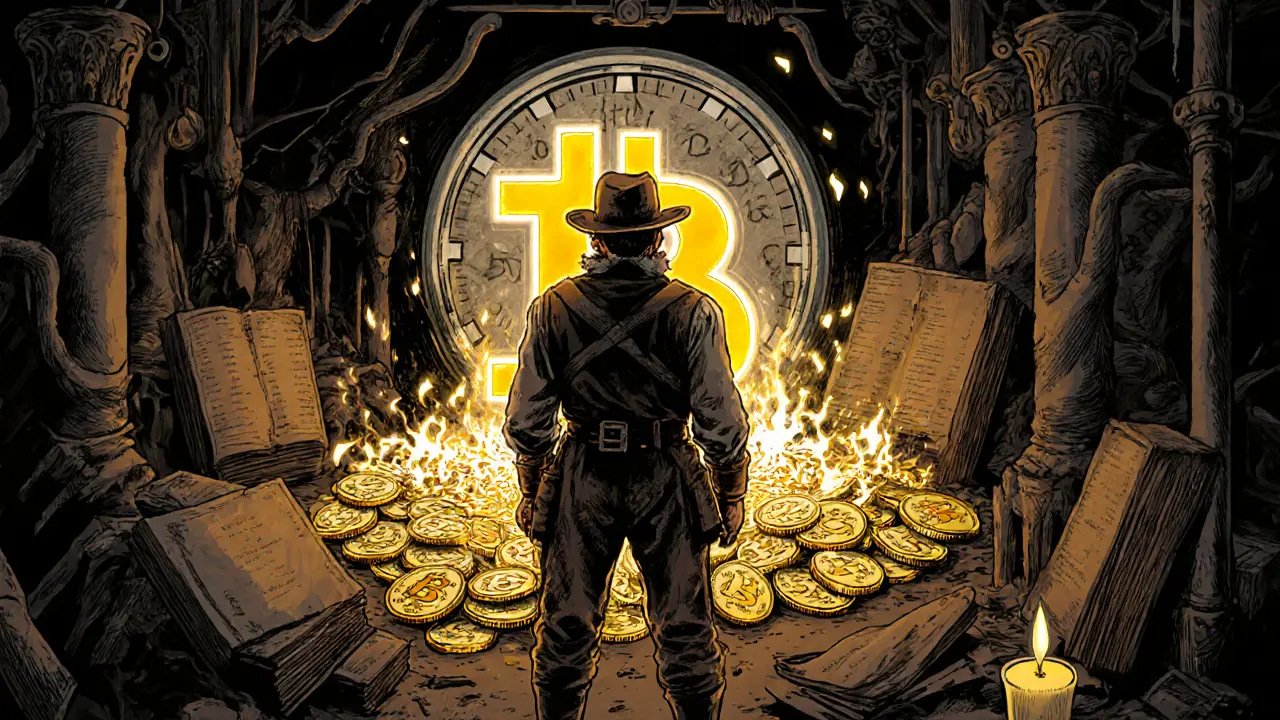Bitcoin Halving Supply Calculator
Current Bitcoin Supply
Supply Analysis
Halving Timeline
| Halving | Date | Block Reward (BTC) | Blocks Remaining |
|---|---|---|---|
| Next Halving | 2028-05-11 | 1.5625 | 1,434,644 |
| After Next Halving | 2032-05-11 | 0.78125 | 2,869,288 |
| After That Halving | 2036-05-11 | 0.390625 | 4,303,932 |
Key Insight: As Bitcoin approaches its 21 million supply cap, each halving creates progressively smaller supply shocks. The 2024 halving reduced the annual supply issuance by less than 2% of market cap, shifting importance to institutional demand and miner behavior.
Bitcoin doesn’t inflate like the dollar. It doesn’t get printed by a central bank. Instead, its supply is locked in code - and every four years, it cuts itself in half. This isn’t just a technical detail. It’s the core of the Halving Supply Shock Theory, a powerful idea that explains why Bitcoin’s price has repeatedly surged after these events - and why some believe it will keep doing so.
What Exactly Is a Bitcoin Halving?
Every 210,000 blocks, Bitcoin’s block reward - the new coins miners earn for securing the network - gets cut by 50%. It started at 50 BTC per block in 2009. Then came 25, then 12.5, then 6.25. The last one happened in April 2024, dropping it to 3.125 BTC per block. This will keep happening until around 2140, when the last Bitcoin is mined and no new coins are created.
This isn’t arbitrary. It’s baked into Bitcoin’s DNA. Satoshi Nakamoto designed it this way to mimic how gold is mined: hard at first, then harder over time. The result? A fixed total supply of 21 million coins. By November 2023, nearly 19.7 million were already in circulation. That means less than 1.3 million are left to be mined - and they’ll come slower and slower.
Unlike fiat currencies, where central banks can print money at will (the U.S. M2 money supply grew 40% between 2020 and 2022), Bitcoin’s supply is predictable. It’s not subject to political decisions, emergency stimulus, or inflation targets. It’s math.
The Supply Shock Mechanism
The Halving Supply Shock Theory argues that when new supply drops by 50% and demand stays the same - or grows - prices must rise. It’s basic economics: less supply, same demand = higher price.
Before each halving, miners were receiving a steady stream of new BTC. After the halving, that stream is cut in half. If miners don’t sell their coins to cover costs, the amount of Bitcoin entering the market drops sharply. That’s the shock.
Historical data backs this up. After the 2012 halving, Bitcoin rose from $12 to over $1,100 in 12 months - an 8,700% gain. In 2016, it jumped from $650 to nearly $20,000 over two years. Even in 2020, despite a global pandemic, it went from $8,800 to $65,000 in 18 months.
But here’s the catch: these gains aren’t guaranteed. The 2022 bear market crashed Bitcoin 65% after the 2020 halving, even though the supply shock happened. Why? Because macro forces - like the Federal Reserve raising interest rates and the collapse of TerraUSD - overwhelmed Bitcoin’s internal mechanics. The theory works best when external conditions are neutral or favorable.
Why It’s Getting Harder to Move the Needle
The bigger Bitcoin gets, the harder it is for a 50% cut in new supply to move the price. Think of it like trying to change the course of an oil tanker with a paddle.
In 2012, Bitcoin’s market cap was under $1 billion. Cutting new supply by half meant removing a tiny fraction of the total circulating supply. In 2024, Bitcoin’s market cap hit $1.2 trillion. The 3.125 BTC block reward now accounts for just 1.8% of that total. To double the price, you’d need $1.2 trillion in new buying - not just a reduction in new supply.
That’s why experts like Geertjan Cap from Swan Bitcoin argue the halving’s price impact is diminishing. In 2012, block rewards made up 30% of Bitcoin’s market cap. Now, they’re barely 2%. The real driver of price isn’t miners selling less - it’s institutional demand. BlackRock’s spot Bitcoin ETF alone brought in $10 billion in its first few months. That’s more than the entire new supply created in a year.

Miners Are the Real Test
Miners are the backbone of Bitcoin. They spend millions on electricity and hardware to earn new coins. When the reward drops, their revenue drops by half - but their costs don’t.
After the 2024 halving, many small miners with high electricity costs (above $0.05/kWh) became unprofitable overnight. Arcane Research estimated 45% of small operators could shut down. That’s not just a business problem - it’s a network security issue. If too many miners leave, the hash rate drops, making Bitcoin vulnerable.
But Bitcoin has a built-in safety valve: the difficulty adjustment. Every two weeks, the network automatically makes mining harder or easier to keep block times at 10 minutes. After the 2018 crash, difficulty fell 28.5% in weeks to keep the chain alive. The same happened after the 2024 halving - hash rate dropped 15% in the first month, and difficulty adjusted down by 17% to compensate.
So while some miners exit, the network adapts. The survivors - usually those with cheap power and efficient hardware - become stronger. This consolidation actually strengthens Bitcoin’s long-term security.
Is the Halving Still Relevant?
Some say no. Critics like Nic Carter of Castle Island Ventures argue that institutional adoption, ETFs, and macro trends now dominate Bitcoin’s price - not the halving. And they’re not wrong. The 2024 halving happened alongside the approval of 11 spot Bitcoin ETFs in the U.S., which brought in over $34 billion in inflows. That dwarfs the impact of halving.
But dismissing the halving entirely misses the point. It’s not the only driver - it’s a catalyst. It creates a predictable moment of scarcity. It focuses attention. It triggers FOMO. And it forces miners and investors to re-evaluate their positions.
On Reddit’s r/Bitcoin, over 1,200 comments in March 2024 debated whether the theory still held. Top replies pointed to Glassnode data showing miner reserves dropped 22% post-2020 halving - meaning miners were holding, not selling. That’s a sign of confidence. On Twitter, traders like @Pentosh1 warned: “2024 halving supply shock is priced in.” But even they didn’t say it was irrelevant - just that it wasn’t the whole story.

What Investors Should Watch
If you’re looking to use the halving as part of your strategy, here’s what actually matters:
- Miner reserves: If miners are holding BTC instead of selling, it’s a bullish signal. After the 2020 halving, reserves fell to their lowest since 2010.
- ETF inflows: The real money now flows through institutional products, not retail hype. Track daily inflows from BlackRock, Fidelity, and others.
- MVRV Z-Score: This metric compares market value to realized value. A score below -1.8 (like in February 2024) signals deep undervaluation - a potential buying opportunity.
- Hash rate recovery: After a halving, if hash rate rebounds quickly, it means miners believe in the long-term price.
Historical patterns suggest buying 90 days before the halving has been profitable - but only if you hold through the volatility. The 2024 cycle proved that timing alone isn’t enough. You need to understand the broader market context.
The Bigger Picture: Scarcity as a New Asset Class
The Halving Supply Shock Theory isn’t just about Bitcoin’s price. It’s about proving that digital assets can have real, verifiable scarcity - something no currency or stock has ever done before.
Gold has limited supply, but no one knows exactly how much is left underground. Bitcoin’s supply is transparent, auditable, and mathematically fixed. Every coin ever mined is recorded on a public ledger. That’s revolutionary.
Even critics admit this. The fact that Bitcoin survives halvings - and keeps growing - proves its model works. Ethereum eliminated block rewards entirely in 2022. Solana has a fixed 5% inflation rate. Bitcoin? It’s the only one that’s built-in disinflation.
By 2036, block rewards will fall below 0.01 BTC. At that point, miners will rely almost entirely on transaction fees. That’s when Bitcoin’s true test begins: can it remain secure without new coin issuance? If yes, then the halving wasn’t just a price trigger - it was a transition mechanism to a fully fee-based economy.
The Halving Supply Shock Theory may not be the sole driver of Bitcoin’s price anymore. But it’s still the most elegant proof that digital scarcity is real - and valuable.
Does the Bitcoin halving always cause a price increase?
No. While Bitcoin’s price has risen after every halving in the past, it’s not guaranteed. In 2022, Bitcoin dropped 65% despite the 2020 halving because of global macro factors like Fed rate hikes and crypto market crashes. The halving creates potential for price growth, but external events can override it.
Why does Bitcoin’s supply halve every four years?
It’s programmed into Bitcoin’s code. Every 210,000 blocks (roughly every four years), the reward for mining a new block is cut in half. This was designed by Satoshi Nakamoto to mimic the decreasing availability of precious metals like gold, creating a predictable, deflationary supply schedule that caps total coins at 21 million.
How do miners survive after a halving?
Miners survive by either reducing costs or increasing efficiency. Many upgrade to newer ASIC hardware, move to regions with cheaper electricity (like Texas or Scandinavia), or rely more on transaction fees. After the 2024 halving, miners with electricity costs above $0.05/kWh became unprofitable, forcing many to shut down. Those with low costs and scale survived - and became stronger.
Is the halving the main reason Bitcoin’s price goes up?
Not anymore. In 2012 and 2016, halvings were the dominant factor. But today, institutional demand - especially from Bitcoin ETFs - drives price more than supply changes. BlackRock’s $10 billion ETF inflows in 2024 had a bigger impact than the 50% drop in new coin issuance. The halving still matters, but it’s now one factor among many.
What happens after all 21 million Bitcoins are mined?
After the last Bitcoin is mined around 2140, miners will no longer receive block rewards. Instead, they’ll rely entirely on transaction fees to earn income. Bitcoin’s security will depend on whether users are willing to pay enough in fees to keep miners active. The halving process was designed to gradually shift Bitcoin from a subsidy-based model to a fee-based one - making it sustainable long-term.
